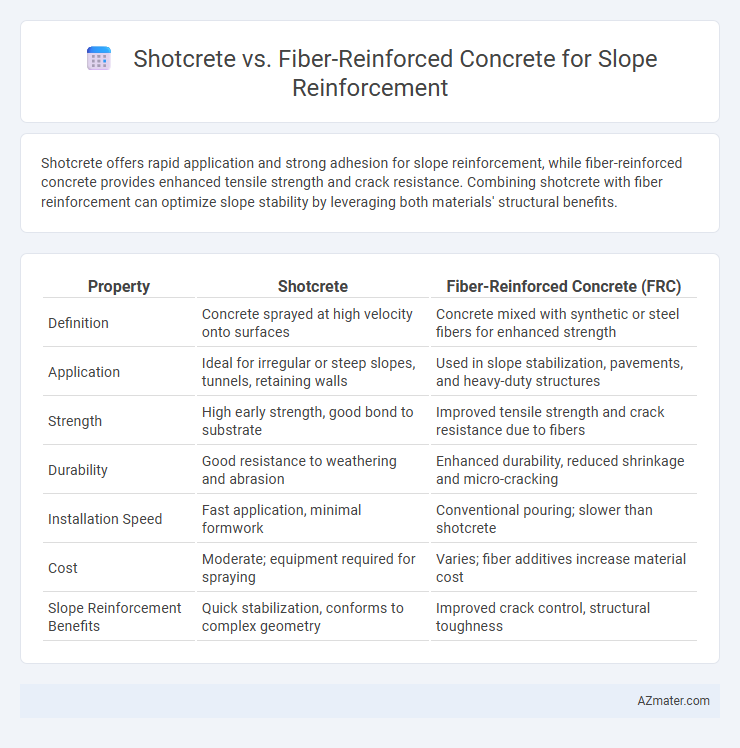Shotcrete offers rapid application and strong adhesion for slope reinforcement, while fiber-reinforced concrete provides enhanced tensile strength and crack resistance. Combining shotcrete with fiber reinforcement can optimize slope stability by leveraging both materials' structural benefits.
Table of Comparison
| Property | Shotcrete | Fiber-Reinforced Concrete (FRC) |
|---|---|---|
| Definition | Concrete sprayed at high velocity onto surfaces | Concrete mixed with synthetic or steel fibers for enhanced strength |
| Application | Ideal for irregular or steep slopes, tunnels, retaining walls | Used in slope stabilization, pavements, and heavy-duty structures |
| Strength | High early strength, good bond to substrate | Improved tensile strength and crack resistance due to fibers |
| Durability | Good resistance to weathering and abrasion | Enhanced durability, reduced shrinkage and micro-cracking |
| Installation Speed | Fast application, minimal formwork | Conventional pouring; slower than shotcrete |
| Cost | Moderate; equipment required for spraying | Varies; fiber additives increase material cost |
| Slope Reinforcement Benefits | Quick stabilization, conforms to complex geometry | Improved crack control, structural toughness |
Introduction to Slope Reinforcement Methods
Slope reinforcement methods primarily include shotcrete and fiber-reinforced concrete, both crucial for enhancing slope stability and preventing erosion. Shotcrete, a sprayed concrete, offers immediate support by creating a dense protective layer, while fiber-reinforced concrete integrates synthetic or steel fibers to improve tensile strength and crack resistance. The choice between these methods depends on factors like slope geometry, load conditions, and environmental exposure, ensuring tailored reinforcement for long-term durability.
What is Shotcrete?
Shotcrete is a method of applying concrete pneumatically at high velocity onto surfaces, commonly used for slope reinforcement due to its rapid application and strong adhesion. This technique allows concrete to be sprayed onto uneven or steep slopes, creating a dense, durable layer that stabilizes soil and rock. Shotcrete often incorporates fiber reinforcement to improve tensile strength and reduce cracking, enhancing slope durability and resistance to erosion.
Understanding Fiber-Reinforced Concrete
Fiber-reinforced concrete (FRC) enhances slope reinforcement by improving tensile strength and crack resistance through the inclusion of synthetic or steel fibers distributed uniformly within the concrete matrix. Compared to shotcrete, FRC offers superior durability against environmental stressors and reduces maintenance costs by mitigating shrinkage cracks and impact damage. Its adaptability to various fiber types and dosages allows for customized performance characteristics tailored to specific slope stabilization requirements.
Key Differences Between Shotcrete and Fiber-Reinforced Concrete
Shotcrete offers rapid placement and high early strength with excellent adhesion for slope stabilization, while fiber-reinforced concrete enhances tensile strength and crack resistance through dispersed fibers within the mix. Shotcrete is typically applied pneumatically, enabling efficient coverage of irregular slopes, whereas fiber-reinforced concrete is cast using conventional methods for improved structural durability. The choice depends on project requirements: shotcrete excels in quick, precise reinforcement, and fiber-reinforced concrete provides long-term toughness and reduced maintenance.
Material Properties and Strength Comparison
Shotcrete offers rapid application and excellent adhesion, making it ideal for irregular slope surfaces, while fiber-reinforced concrete (FRC) enhances tensile strength and crack resistance through the integration of synthetic or steel fibers within the concrete matrix. Material properties of shotcrete include high early strength and ease of placement, whereas FRC demonstrates superior toughness and durability under tensile stress due to fiber dispersion. Strength comparison reveals that FRC can achieve improved post-cracking behavior and energy absorption, whereas shotcrete excels in compressive strength and structural bonding for immediate slope stabilization.
Installation Techniques and Equipment Requirements
Shotcrete installation for slope reinforcement involves pneumatically spraying concrete onto surfaces, requiring specialized equipment such as high-pressure hoses, compressors, and nozzle operators skilled in controlling rebound and achieving uniform thickness. Fiber-reinforced concrete, typically placed by conventional pouring or pumping methods, demands less specialized equipment but necessitates thorough mixing to ensure even fiber dispersion and optimal performance. Both techniques require proper surface preparation and skilled labor, yet shotcrete excels in rapid placement on steep slopes, while fiber-reinforced concrete offers enhanced tensile strength with simpler installation logistics.
Durability and Long-Term Performance
Shotcrete offers excellent adhesion and rapid application for slope reinforcement, but fiber-reinforced concrete enhances durability through improved crack resistance and tensile strength. The inclusion of fibers in concrete significantly reduces shrinkage cracks and enhances impact resistance, leading to superior long-term performance in erosive or seismic environments. Fiber-reinforced concrete's ability to maintain structural integrity under cyclic loading makes it more reliable for prolonged slope stabilization compared to traditional shotcrete.
Cost Analysis: Shotcrete vs Fiber-Reinforced Concrete
Shotcrete typically incurs higher initial costs due to specialized spraying equipment and skilled labor requirements, whereas fiber-reinforced concrete lowers long-term expenses by reducing crack propagation and maintenance needs. Fiber-reinforced concrete enhances durability and structural integrity, leading to fewer repairs and extended slope lifespan, which improves overall cost efficiency. Evaluating project-specific factors such as slope size, environmental conditions, and lifespan expectations is essential for a comprehensive cost-benefit analysis.
Environmental Impact and Sustainability
Shotcrete demonstrates lower environmental impact in slope reinforcement due to reduced material transport and minimal waste generation, promoting sustainability in construction. Fiber-reinforced concrete enhances durability and crack resistance, extending slope life and decreasing the need for frequent repairs, which reduces long-term resource consumption and carbon footprint. Both methods support sustainable engineering by improving slope stability and minimizing ecological disturbances when selected based on site-specific conditions.
Choosing the Right Solution for Slope Stabilization
Shotcrete offers rapid application and excellent adhesion to irregular surfaces, making it ideal for quick slope stabilization in emergency or complex terrains. Fiber-reinforced concrete enhances tensile strength and crack resistance, providing long-term durability and improved load distribution on slopes subject to dynamic forces. Selecting the right solution depends on factors like slope geometry, load conditions, site accessibility, and the anticipated lifespan of the reinforcement, with shotcrete favored for immediate stabilization and fiber-reinforced concrete chosen for sustainable, high-performance slope protection.

Infographic: Shotcrete vs Fiber-reinforced Concrete for Slope Reinforcement
 azmater.com
azmater.com